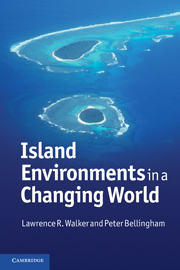Book contents
- Frontmatter
- Contents
- Preface
- Photo credits
- 1 Introduction to island environments and cultures
- 2 The physical setting
- 3 Natural disturbances on islands
- 4 The plants and animals of islands
- 5 Human dispersal, colonization, and early environmental impacts
- 6 Intensifying human impacts on islands
- 7 Islands in the modern world, 1950–2000
- 8 The future of island ecosystems: remoteness lost
- Glossary
- Index
- Plate section
- References
3 - Natural disturbances on islands
Published online by Cambridge University Press: 05 June 2012
- Frontmatter
- Contents
- Preface
- Photo credits
- 1 Introduction to island environments and cultures
- 2 The physical setting
- 3 Natural disturbances on islands
- 4 The plants and animals of islands
- 5 Human dispersal, colonization, and early environmental impacts
- 6 Intensifying human impacts on islands
- 7 Islands in the modern world, 1950–2000
- 8 The future of island ecosystems: remoteness lost
- Glossary
- Index
- Plate section
- References
Summary
DISTURBANCE CHARACTERISTICS
The geological and geographical processes discussed in Chapter 2 are dynamic over millions of years as islands form and change shape. Changes in the physical environment also occur over annual and decadal scales that are more relevant to plants and animals on islands. When these changes disrupt living organisms by causing a reduction of biomass (plant or animal matter) or structure (such as the canopy of a forest) we call them disturbances. Some of these disturbances are on-going tectonic events, such as volcanoes, earthquakes, and slope erosion. Other disturbances arise from the presence of the organisms themselves, such as when seabirds dig burrows in the ground or flammable plants promote the spread of fires. In this chapter, we discuss both the physical and the biological disruptions to the plants and animals on the nine island groups. The emphasis in this chapter is on natural disturbances as we set the stage for understanding the arrival and evolution of the diversity of plants and animals that inhabit islands (see Chapter 4). These initial chapters then provide a framework within which to understand the influences of humans on island biota (anthropogenic disturbances, see Chapters 5–8).
Disturbances that damage living organisms are relatively discrete events that alter the structure of a community or ecosystem. Events that occur over longer periods of time, such as a gradual depletion of nutrients from the soil or a gradual change in air temperature are considered stresses rather than disturbances.
- Type
- Chapter
- Information
- Island Environments in a Changing World , pp. 64 - 115Publisher: Cambridge University PressPrint publication year: 2011



